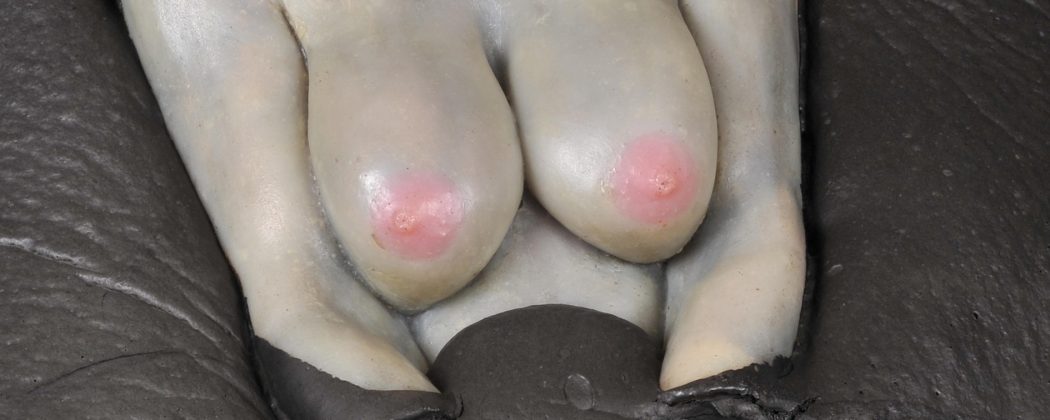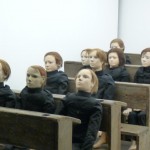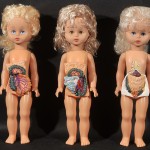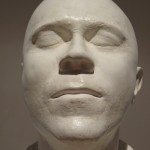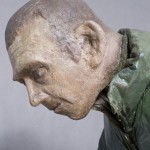Innowacje i nowe technologie konserwacji dotyczące badań i ochrony dzieł sztuki z tworzyw sztucznych. Zrównoważony rozwój poprzez zbudowanie bazy wiedzy dla badań identyfikacyjnych, metodyki konserwacji i ekspozycji w kolekcjach i przestrzeni publicznej
Innovations and new technologies devoted to the conservation of artworks of plastic. Sustainability through building a knowledge for identification, research and methodologies of conservation in the collections and public space Projekt został sfinansowany: ze środków Narodowego Centrum Nauki przyznanych na podstawie decyzji numer DEC-2011/01/B/HS2/06182 The project was financed from the resources of the National Center for Science allocated on the basis of decision No DEC-2011/01/B/HS2/1/06182. Projekt realizowany przy współpracy z: Wydziałami Chemii Politechniki Warszawskiej i Uniwersytetu Warszawskiego, a także instytucjami kultury, takimi jak: Zachęta - Narodowa Galeria Sztuki i Muzeum Sztuki Nowoczesnej w Warszawie, Cricoteka Ośrodek Dokumentacji Sztuki Tadeusza Kantora w Krakowie, Fundacja Galerii Foksal w Warszawie, Muzeum Narodowe we Wrocławiu, Galeria Propaganda i Galeria Salon Akademii w Warszawie. In cooperation with: WKiRDS Laboratory, Chemistry Departments of Warsaw University of Technology and University of Warsaw, The National Gallery Zacheta, Museum of Modern art in Warsaw, Cricoteca -Centre for the Documentation of the Art of Tadeusz Kantor in Krakow, Foksal Gallery Foundation in Warsaw, National Museum in Wroclaw, Propaganda Gallery and Salon Academy Gallery in Warsaw Kierownik grantu: dr Monika Jadzińska / Supervisor: PhD Monika Jadzińska Współpraca naukowa / Scientific Cooperation: prof. dr hab. Paweł Parzuchowski, dr Irmina Zadrożna, prof. dr hab. Iwona Szmelter Współpraca / Cooperation: Roman Stasiuk, Joanna Kurkowska, Kamila Załęska, Aleksandra Wesołowska, Monika Słomczyńska, Marcin Ciężadlik, Andrzej Kowalczyk, Jan Raczkowski, Ula Kusz, Joanna Waśko, Małgorzata Bogdańska-Krzyżanek, Aleksandra Kozioł, Barbara Paluch-Nowak, Elżbieta Bień-Kalemba i inni. Okres realizacji / Period: 12.2011-09.2015 Keywords: cultural heritage of XX/XXI century, sustainability, identification, maintenance, innovation and new technologies, plasticts in artworks and conservation treatments Tworzywa sztuczne ustanowiły rewolucję cywilizacyjną w XX i XXI wieku, wpływając na standardy i estetykę w każdej sferze życia, także w dziedzinie kultury. W sztuce sprawiają ogromne problemy związane z nietrwałością, złym stanem zachowania i fatalnymi prognozami na przyszłość. Mimo to zwyczajowo traktowane są wciąż jako materiały „młode”, trwalsze od tradycyjnych. W rzeczywistości jest odwrotnie, a wiele dzieł sztuki ulega nieodwracalnej degradacji. Aby uratować współczesne dziedzictwo kultury i sztuki, będące świadectwem naszych czasów dla przyszłych pokoleń należało rozpoznać, opisać, zidentyfikować i przedstawić środki zaradcze dla ratowania spuścizny, która od lat 60-tych XX wieku w dużym stopniu tworzona jest z wykorzystaniem tworzyw polimerowych. Zagadnienia nowatorskie, podejmowane są w tak szerokim spektrum po raz pierwszy w Polsce (na świecie od lat 90-tych XX wieku). Głównym i osiągniętym celem projektu było wyznaczenie standardów, określenie i propozycje rozwiązań problemów ochrony dzieł sztuki z tworzyw sztucznych, poprzez synergię działań identyfikujących i ustalenie metodyki postępowania na polu opieki, konserwacji i ekspozycji, stworzenie aktualnej metodologii identyfikacji i modelu dokumentacji wraz z wdrożeniem poprzez wykorzystanie istniejącej wiedzy, osiągnięcia naukowe oraz innowacyjne technologie. Stworzono platformę wiedzy o tworzywach sztucznych w dziedzictwie kultury na podstawie szeroko zakrojonych, interdyscyplinarnych badań. EFEKTY: 1. usystematyzowanie i rozwój wiedzy o materiałach syntetycznych w dziełach sztuki na polu historii współczesnej kultury Polskiej na tle światowej (XIX/XXI w.) 2. specyfikacja chemiczna, fizyczna, techniczna najczęściej używanych przez artystów materiałów syntetycznych z uwzględnieniem procesów otrzymywania, właściwości i procesów starzeniowych 3. opracowanie dotyczące metod identyfikacji materiałów syntetycznych 4. wdrożenie wybranych metod identyfikacyjnych w obiektach czołowych polskich artystów: P. Althamer, J. Antonisz, M. Bałka, T. Borowski, S. Dróżdż, T. Kantor, E. Krasiński, Z. Libera, A. Szapocznikow, L. Tarasewicz, J. Tarasin, J. Wójcik, K. Zarębski. Przebadanie wybranych obiektów w/w artystów ze szczególnym uwzględnieniem identyfikacji polimerów i dodatków (plastyfikatorów, wypełniaczy, pigmentów itp.) Zastosowane metody i techniki badawcze: analizy mikrochemiczne (opis i zdjęcie mikroskopowy w świetle przechodzącym VIS i UV, opis rozpuszczalności, spalania), stratygrafia, badania: FTIR, ATR-FTIR, spektroskopia Ramana, DSC, GPC, NMR, SEM-EDS, GC/MS. 5. współpraca na polu ochrony dzieł sztuki, wymiany informacji, dzielenia doświadczeń (wywiady z kuratorami, konserwatorami, inwentaryzatorami, artystami/współpracownikami, rodziną) z państwowymi i prywatnymi instytucjami zajmującymi się gromadzeniem, wystawianiem, obrotem dziełami sztuki współczesnej, a także kolekcjami prywatnymi artystów: m.in. Narodowa Galeria Zachęta w Warszawie, Cricoteka Ośrodek Dokumentacji Sztuki Tadeusza Kantora w Krakowie, Muzeum sztuki Nowoczesnej w Warszawie, Fundacja Galerii Foksal w Warszawie, Muzeum Narodowe we Wrocławiu, Galeria Propaganda i Galeria Salon Akademii w Warszawie. 6. stworzenie modelu dokumentacji i rejestracji dzieł sztuki współczesnej wykorzystujących tworzywa sztuczne w oparciu o model INCCA i inne; aplikacja modelu dla konkretnych, poddanych analizie obiektów 7. zebranie informacji dotyczących historii zastosowania tworzyw sztucznych w konserwacji 8. praktyczne wykorzystanie tworzyw sztucznych w aktualnej sztuce – ocena możliwości, praktyki i zagrożeń na podstawie doświadczeń i realizacji (obiektów ruchomych jak również znajdujących się na stałe w przestrzeni publicznej) artystów poznańskich, a także wykładowców i studentów Uniwersytetu Sztuk Pięknych w Poznaniu 9. analiza mechanizmów starzenia i żywotności (lifespan) obiektów sztuki stworzonych z tworzyw sztucznych przechowywanych w warunkach muzealnych, a także rzeźb w przestrzeni publicznej, narażonych na działanie zewnętrznych warunków klimatycznych 10. analiza potrzeb i propozycja rozwiązań zachowawczych; długoterminowa metodyka konserwacji-restauracji, prewencja, przechowywanie, transport 11. określenie warunków i zagrożeń związanych z ekspozycją w kolekcjach i przestrzeni publicznej 12. gromadzenie danych tekstowych i fotograficznych dot. dzieł sztuki i obiektów współczesnych i ich stanu zachowania dla budowania bazy danych obiektów stworzonych z w/w materiałów (fotografie obiektów z polskich, jak również zagranicznych kolekcji muzealnych i galeryjnych (Europa, Australia, Brazylia, Japonia), oraz cyklicznych wystaw czasowych, takich jak np. Biennale w Wenecji. 13. przygotowanie monografii na poziomie naukowym 14. przygotowanie guidelines dla szerszej rzeszy odbiorców 15. aspekt naukowy: projekt stanowi bazę dla przewodu habilitacyjnego dr Moniki Jadzińskiej (planowa obrona: 2016r.); zaangażowanie studentów i magistrantów Wydziału Konserwacji i Restauracji Dzieł Sztuki, ASP w Warszawie w podejmowaną tematykę (w formie 3 prac naukowych dla 5 roku i 2 prac magisterskich oraz dyplomowych) 16. szerokie, krajowe i międzynarodowe, wielopłaszczyznowe upublicznianie cząstkowych i finalnych efektów projektu, skierowane do różnych środowisk (profesjonalistów: konserwatorów, kuratorów, historyków sztuki, socjologów, filozofów, chemików, fizyków, ludzi odpowiedzialnych za edukację, dyrektorów muzeów, a także ludzi nie związanych bezpośrednio z kulturą i sztuką): referaty i postery na międzynarodowych i krajowych konferencjach, udział w warsztatach tematycznych 17. Publikacje artykułów naukowych Efekty projektu wpływają na poszerzenie wiedzy i doświadczenia w dziedzinie konserwacji i restauracji dzieł sztuki, a pośrednio uruchamiają pozytywny wpływ na rozwój takich dyscyplin jak chemia, fizyka, historia sztuki, jak również, poprzez popularyzatorskie formy trafiające do przeciętnego odbiorcy – (guidelines) na uwrażliwienie społeczne. Zaproponowane rozwiązania mogą być zastosowane w praktyce muzealnej, przestrzeni publicznej i prywatnej, stanowiąc odpowiedz na potrzeby kulturowe i społeczne dzisiejszych czasów. Efekty interdyscyplinarnych badań były prezentowane i dyskutowane w krajowych i międzynarodowych gronach profesjonalistów nauk ścisłych (Cypr, Berlin, Monachium, Warszawa); humanistów – socjologów, filozofów, animatorów kultury i edukacji (Baden Baden, Liubliana); architektów, historyków sztuki, muzealników, kuratorów, konserwatorów (organizacje: ICOM, ICOM-CC, ICOMOS, CIMAM), konserwatorów (Glasgow, Berlin, Monachium), co poszerzyło krąg ludzi świadomych rozwoju polskiej nauki w dziedzinie szeroko rozumianej ochrony dziedzictwa kultury i sztuki. PUBLIKACJE: M. Jadzińska, Artist’s experiments with new materials in works of art: How to preserve intent and matter, ://Authenticity in Transition, ARCHETYPE, London (2016) M. Jadzińska, A New Era in Conservation? Synergy in the Analysis, Conservation and Protection in the Preservation of Contemporary and Modern Art, ://Between Art and Science, Wydawnictwo ASP, Warszawa (2016) M. Jadzińska, P. Parzuchowski, Complex care for contemporary art heritage - research project: Plastics in art in Poland, ://FUTURE TALKS 013, Technology and Conservation of Modern Materials in Design, Pinakothek der Moderne 10/23/ to 10/25/2013, (2015) M. Jadzińska, New materials in works of art (plastics) – the challenge of our times. Synergy in the field of recognition, damage assessment and protection, ://EUROMED, Multi-Science Publishing Co. LTD, UK, (2015) M. Jadzińska, P. Parzuchowski, Plastic work of art - challenge of our time. FTIR, RAMAN, NMR, XRF analysis of artworks by T. Kantor, A. Szapocznikow, P. Althamer and M. Bałka, CFP: Forum: Plastics History 2014 "Plastics Heritage", Berlin, Hochschule für Technik und Wirtschaft (University of Applied Science) HTW in Berlin 22-24 Oct 2014, Germany, (2015) M. Jadzińska, Pięć ścieżek w stronę popularyzacji ochrony dziedzictwa kultury. Spostrzeżenia akademika i konserwatora, ://Nauczanie i popularyzacja ochrony dziedzictwa, Polski Komitet Narodowy ICOMOS, Politechnika Lubelska, Warszawa 2014, p. 229-237 M. Jadzińska, Artist’s experiments with new materials and technologies and its consequences. Questions about the authenticity of material, form or idea, ://Art and Science, Proceeding of a 12th Special Forum Symposium on Art and Science, held as part of The 25nd International Conference on System Research, Informatics and Cybernetics, 2013, Baden Baden, 2014 M. Jadzińska, Think of culture, care for art. Preservation of contemporary heritage in modern society, ://Proceedings of the Information Society Conference, Ljubliana 2013, p. 438-443 KONFERENCJE (wybrane): M. Jadzińska, Artist’s experiments with new materials in works of art: How to preserve intent and matter, International Conference Authenticity in Transition, Changing practices in Contemporary Art Making and Conservation, 1-2.12.2014, Glasgow, referat M. Jadzińska, New materials in works of art (plastics) – the challenge of our times. Synergy in the field of recognition, damage assessment and protection, International Conference EUROMED 2014 dedicated on Cultural Heritage Documentation, Preservation and Protection, 3-8.11.2014, Limassol, Cypr, referat, poster M. Jadzińska, P. Parzuchowski, Plastic work of art - challenge of our time. FTIR, RAMAN, NMR, XRF analysis of artworks by T. Kantor, A. Szapocznikow, P. Althamer and M. Bałka, CFP: Forum: Plastics History 2014 "Plastics Heritage", HTW Hochschule für Technik und Wirtschaft (University of Applied Science) 22-24.10.2014, Berlin, poster M. Jadzińska, Artist’s experiments with new materials and technologies and its consequences. Questions about the authenticity of material, form or idea, IIAS Art and Science, 12th Special Forum Symposium on Art and Science, held as part of The 25nd International Conference on System Research, Informatics and Cybernetics, 4-9.08.2014, Baden Baden, referat M. Jadzińska, P. Parzuchowski, Plastic work of art. FTIR, RAMAN, NMR, XRF analysis of artworks by T. Kantor, A. Szapocznikow, M. Bałka and P. Althamer, 5th Meeting X-ray and other techniques in investigations of the objects of cultural heritage, Celebrating the International Year of Crystallography and the 650th Anniversary of Jagiellonian University, 14-17 May 2014, Krakow, poster M. Jadzińska, P. Parzuchowski, Complex care for contemporary art heritage - research project: Plastics in art in Poland, FUTURE TALKS 013, Technology and Conservation of Modern Materials in Design, Pinakothek der Moderne 23-25.10.2013, Monachium, poster M. Jadzińska, Think of culture, care for art. Preservation of contemporary heritage in modern society, the Information Society Conference, 16th International Multiconference 7-11.10.2013, Ljubliana, referat M. Jadzińska, Pięć ścieżek w stronę popularyzacji ochrony dziedzictwa kultury. Spostrzeżenia akademika i konserwatora, Nauczanie i popularyzacja ochrony dziedzictwa, Konferencja ICOMOS, Arkady Kubickiego, 5-6.12.2013, Warszawa, referat M. Jadzińska, P. Parzuchowski, I. Zadrożna, I. Szmelter, Tworzywa sztuczne w dziełach sztuki w Polsce – interdyscyplinarny projekt badawczy, Analiza Chemiczna w Ochronie Zabytków, 5-6.12.2013, Warszawa, poster ENGLISH Plastics set up the revolution in the 20th and 21st centuries, influencing the standards and aesthetics in every sphere of life, including the field of culture. In art there is a great problem with plastics impermanence, bad state of conservation and concerns for their future preservation. Although they are customarily still treated as "young" materials, more durable than traditional ones, the fact is, it is the opposite, and many works of art undergo irreversible degradation. To save the heritage of modern art and culture, which is a testament of our times for future generations, it was necessary to recognize, describe, identify and provide remedies for rescuing art composed of plastic. Since the 60s of the 20th century, to a large extent, history is created with the use of polymer materials. Comprehensive research of those issues in such a wide range is being undertaken for the first time in Poland. The main aim of the project was to establish standards and proposals for solutions to the problems of protection for works of art made of plastics, through a synergy of activities that identify and determine the methodology of the proceedings of the care, maintenance and exposure. The effort targeted creation of the current methodology for the identification and documentation of the preservation models with the implementation through the use of existing knowledge, scientific achievements and innovative technologies. The knowledge accumulated was based on the basis of broad, interdisciplinary research. The understanding of synthetic materials in the works of art in the contemporary history of Polish culture was systematised and correlations were made to the larger, World art scene of the 20th and 21st Century. Chemical specifications were drawn up, and the most frequently used synthetic materials including processes for obtaining, properties and ageing processes have been developed. Selected methods were implemented in 38 case studies - objects of leading Polish artists: P. Althamer, , J. Antonisz, M. Bałka, T. Borowski, S. Dróżdż, T. Kantor, E. Krasinski, Z. Libera, A. Szapocznikow, L. Tarasewicz, J. Tarasin, J. Wojcik, K. Zarębski. Uses among others: microchemical analysis, stratigraphy, descriptions and microscopic photos in transmitted light (UV-VIS); research: FTIR, ATR-FTIR, Raman Spectroscopy, DSC, GPC, NMR, SEM-EDS, TGA, HPLC, GC/MS (in cooperation with: WKiRDS Laboratory, Chemistry Departments of Warsaw University of Technology and University of Warsaw). The exchange of information and knowledge was conducted with the various cultural institutions (among others The National Gallery Zacheta, Museum of Modern art in Warsaw, Cricoteca -Centre for the Documentation of the Art of Tadeusz Kantor in Krakow, Foksal Gallery Foundation in Warsaw, National Museum in Wroclaw, Propaganda Gallery and Salon Academy Gallery in Warsaw). The model of plastic contemporary art’ documentation was created; the history of using plastics in conservation treatment was collected, and an analysis of the mechanisms of aging and life span of art objects made of plastics were carried out. The methodology of preventive maintenance was defined. The possibilities and risks of plastics usage in the modern art based on the experiences of artists from Poznań, as well as the teachers and students of USP, were mentioned. The effects of the project influence the expansion of knowledge and understanding in the field of conservation and restoration of works of art. It also indirectly positively impacts the development of such disciplines as chemistry, physics, history of art, and raises social awareness of an average consumer of art. The proposed solutions can be applied in museum’s practice, public and private space answering cultural and social needs of today's times. Effects of interdisciplinary research were presented and discussed amongst national and international scientists (Cyprus, Berlin, Munich, London); humanists-sociologists, philosophers, cultural entertainers and educators (Baden Baden, Liubliana); architects, art historians, curators, restorers (organizations: ICOM, ICOM-CC, ICOMOS, CIMAM), conservators (Glasgow, Berlin, Munich), which extended the circle of people being aware of the development of Polish science in the field of protection and care of cultural heritage and art. PUBLICATIONS: M. Jadzińska, Artist’s experiments with new materials in works of art: How to preserve intent and matter, ://Authenticity in Transition, ARCHETYPE, London (2016) M. Jadzińska, A New Era in Conservation? Synergy in the Analysis, Conservation and Protection in the Preservation of Contemporary and Modern Art, ://Between Art and Science, Wydawnictwo ASP, Warsaw (2016) M. Jadzińska, P. Parzuchowski, Complex care for contemporary art heritage - research project: Plastics in art in Poland, ://FUTURE TALKS 013, Technology and Conservation of Modern Materials in Design, Pinakothek der Moderne 10/23/ to 10/25/2013, (2015) M. Jadzińska, New materials in works of art (plastics) – the challenge of our times. Synergy in the field of recognition, damage assessment and protection, ://EUROMED, Multi-Science Publishing Co. LTD, UK, (2015) M. Jadzińska, P. Parzuchowski, Plastic work of art - challenge of our time. FTIR, RAMAN, NMR, XRF analysis of artworks by T. Kantor, A. Szapocznikow, P. Althamer and M. Bałka, CFP: Forum: Plastics History 2014 "Plastics Heritage", Berlin, Hochschule für Technik und Wirtschaft (University of Applied Science) HTW in Berlin 22-24 Oct 2014, Germany, (2015) M. Jadzińska, Pięć ścieżek w stronę popularyzacji ochrony dziedzictwa kultury. Spostrzeżenia akademika i konserwatora, ://Nauczanie i popularyzacja ochrony dziedzictwa, Polski Komitet Narodowy ICOMOS, Politechnika Lubelska, Warsaw 2014, p. 229-237 M. Jadzińska, Artist’s experiments with new materials and technologies and its consequences. Questions about the authenticity of material, form or idea, ://Art and Science, Proceeding of a 12th Special Forum Symposium on Art and Science, held as part of The 25nd International Conference on System Research, Informatics and Cybernetics, 2013, Baden Baden, 2014 M. Jadzińska, Think of culture, care for art. Preservation of contemporary heritage in modern society, ://Proceedings of the Information Society Conference, Ljubliana 2013, p. 438-443 CONFERENCES: M. Jadzińska, Artist’s experiments with new materials in works of art: How to preserve intent and matter, International Conference Authenticity in Transition, Changing practices in Contemporary Art Making and Conservation, 1-2.12.2014, Glasgow, paper M. Jadzińska, New materials in works of art (plastics) – the challenge of our times. Synergy in the field of recognition, damage assessment and protection, International Conference EUROMED 2014 dedicated on Cultural Heritage Documentation, Preservation and Protection, 3-8.11.2014, Limassol, Cypr, paper, poster M. Jadzińska, P. Parzuchowski, Plastic work of art - challenge of our time. FTIR, RAMAN, NMR, XRF analysis of artworks by T. Kantor, A. Szapocznikow, P. Althamer and M. Bałka, CFP: Forum: Plastics History 2014 "Plastics Heritage", HTW Hochschule für Technik und Wirtschaft (University of Applied Science) 22-24.10.2014, Berlin, poster M. Jadzińska, Artist’s experiments with new materials and technologies and its consequences. Questions about the authenticity of material, form or idea, IIAS Art and Science, 12th Special Forum Symposium on Art and Science, held as part of The 25nd International Conference on System Research, Informatics and Cybernetics, 4-9.08.2014, Baden Baden, paper M. Jadzińska, P. Parzuchowski, Plastic work of art. FTIR, RAMAN, NMR, XRF analysis of artworks by T. Kantor, A. Szapocznikow, M. Bałka and P. Althamer, 5th Meeting X-ray and other techniques in investigations of the objects of cultural heritage, Celebrating the International Year of Crystallography and the 650th Anniversary of Jagiellonian University, 14-17 May 2014, Krakow, poster M. Jadzińska, P. Parzuchowski, Complex care for contemporary art heritage - research project: Plastics in art in Poland, FUTURE TALKS 013, Technology and Conservation of Modern Materials in Design, Pinakothek der Moderne 23-25.10.2013, Monachium, poster M. Jadzińska, Think of culture, care for art. Preservation of contemporary heritage in modern society, the Information Society Conference, 16th International Multiconference 7-11.10.2013, Ljubliana, paper M. Jadzińska, Pięć ścieżek w stronę popularyzacji ochrony dziedzictwa kultury. Spostrzeżenia akademika i konserwatora, Nauczanie i popularyzacja ochrony dziedzictwa, Konferencja ICOMOS, Arkady Kubickiego, 5-6.12.2013, Warszawa, paper M. Jadzińska, P. Parzuchowski, I. Zadrożna, I. Szmelter, Tworzywa sztuczne w dziełach sztuki w Polsce – interdyscyplinarny projekt badawczy, Analiza Chemiczna w Ochronie Zabytków, 5-6.12.2013, Warszawa, poster

